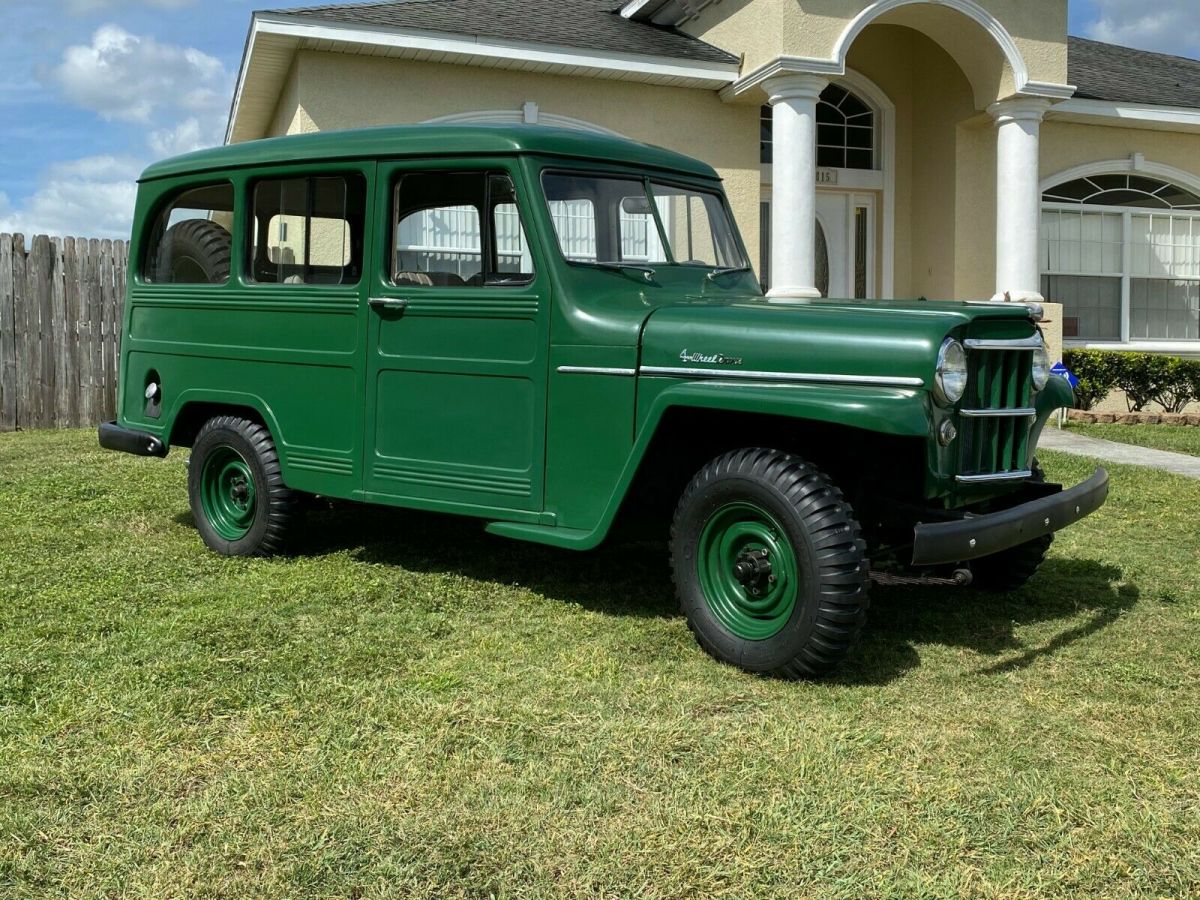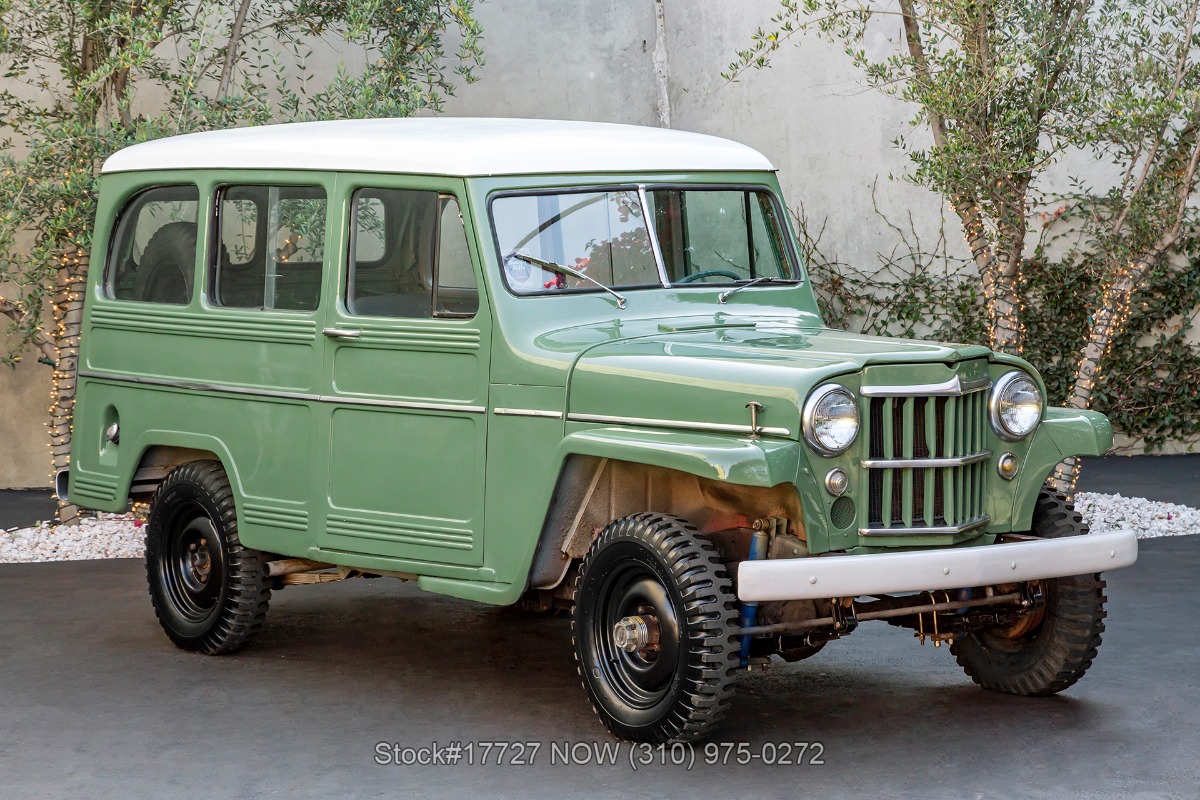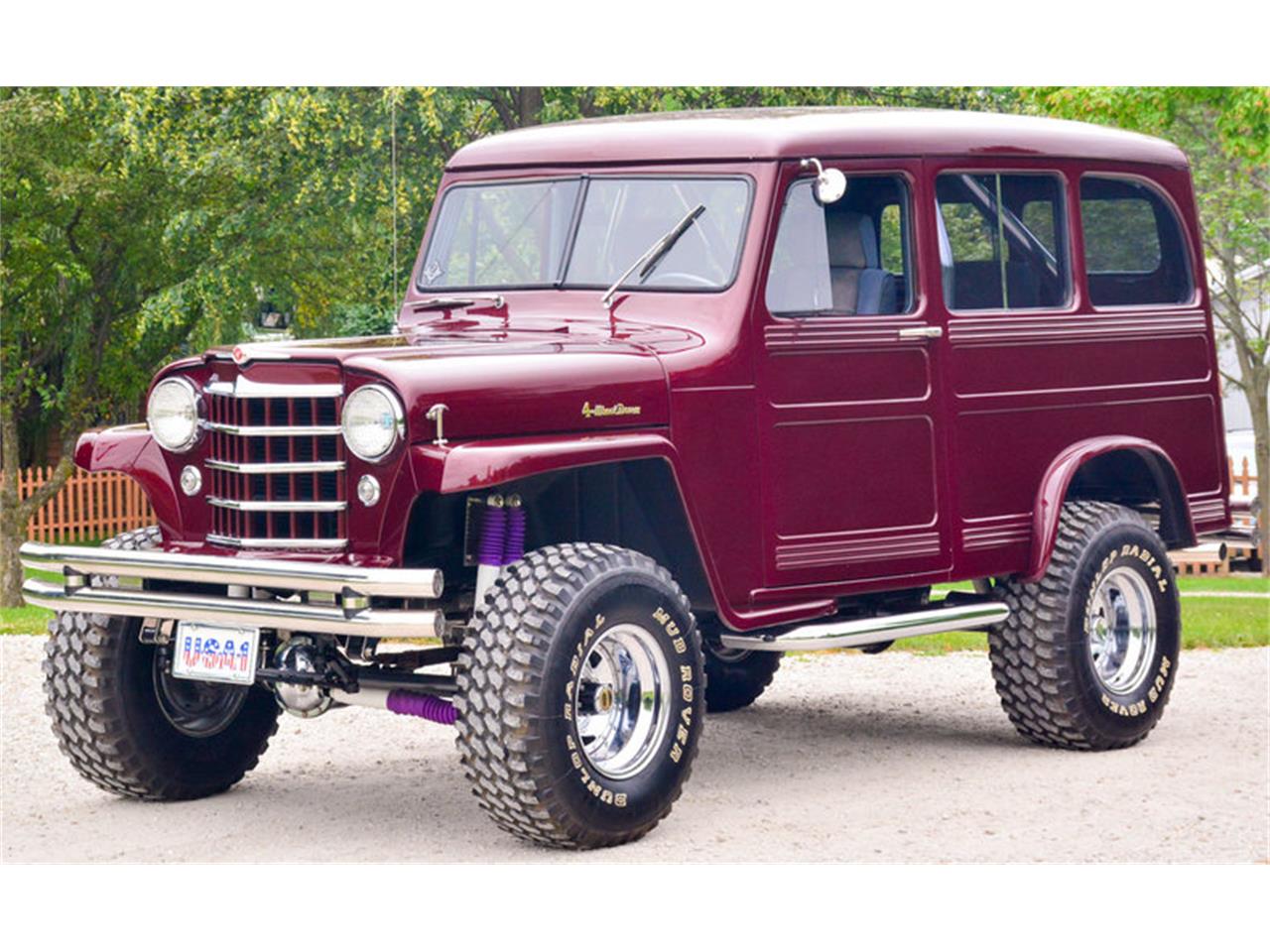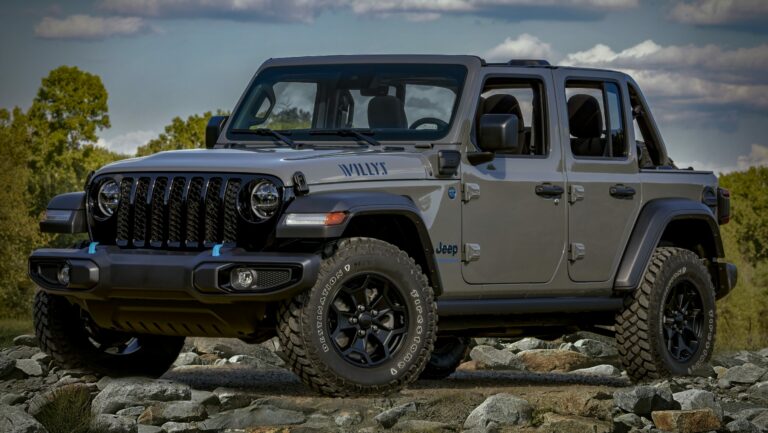Willys Jeep Station Wagons For Sale: A Comprehensive Guide to Owning a Piece of Automotive History
Willys Jeep Station Wagons For Sale: A Comprehensive Guide to Owning a Piece of Automotive History jeeps.truckstrend.com
Introduction: Unearthing the Enduring Appeal of Willys Jeep Station Wagons
In the annals of automotive history, few vehicles possess the iconic status and rugged charm of the Willys Jeep Station Wagon. Born from the post-World War II civilian vehicle boom, these pioneering machines, produced by Willys-Overland Motors, carved out a unique niche as the world’s first mass-produced all-steel station wagons and precursors to the modern Sport Utility Vehicle (SUV). More than just utilitarian transport, the Willys Wagon embodied an adventurous spirit, offering families and businesses alike a versatile, durable, and surprisingly comfortable ride, whether on paved roads or rugged trails.
Willys Jeep Station Wagons For Sale: A Comprehensive Guide to Owning a Piece of Automotive History
Today, "Willys Jeep Station Wagons For Sale" isn’t just a search query; it’s an invitation to explore a vibrant classic car market, a quest for a tangible piece of Americana, and an opportunity to embark on a unique ownership journey. These vintage workhorses have transcended their original purpose, becoming highly sought-after collector’s items, rewarding restoration projects, and distinctive weekend cruisers. For enthusiasts, restorers, or anyone simply yearning for a vehicle with character and a story, understanding the nuances of acquiring and owning a Willys Jeep Station Wagon is essential. This comprehensive guide will delve into every aspect of finding, evaluating, purchasing, and maintaining these automotive legends.
A Legacy of Utility: Understanding the Willys Jeep Station Wagon
The Willys Jeep Station Wagon, introduced in 1946, was a groundbreaking vehicle designed by Brooks Stevens. Its all-steel body construction was a significant departure from the wood-bodied "woody" wagons prevalent at the time, offering greater durability, safety, and reduced maintenance. Initially available only with two-wheel drive, the iconic 4×4 version, which truly cemented its go-anywhere reputation, was introduced in 1949.
Under the hood, early models were powered by the venerable "Go-Devil" L-head four-cylinder engine, inherited from the military Jeep. This was later succeeded by the more powerful "Hurricane" F-head four-cylinder engine in 1950, which provided improved horsepower and torque. Six-cylinder engine options, including the "Super Hurricane," also became available in later years, offering even more capability. Transmissions were typically a rugged three-speed manual (the T-90) paired with a robust Dana 18 transfer case for 4×4 models, sending power to solid axles (Dana 25/27 front and Dana 41/44 rear).
The Willys Wagon’s interior was spartan but functional, offering ample space for passengers and cargo. Its rugged chassis and leaf-spring suspension provided a durable platform capable of handling diverse terrains. Over its production run, which lasted until 1964 (though production continued under Kaiser and later AMC in various forms), the Willys Wagon saw numerous iterations, including panel delivery variants and even pickup truck versions sharing the same basic platform. Its enduring appeal lies in its straightforward design, mechanical simplicity, and the undeniable charm of its classic, no-nonsense styling.
Why Buy a Willys Jeep Station Wagon Today? The Allure of Vintage Utility
Owning a Willys Jeep Station Wagon in the 21st century is a decision driven by more than just transportation needs. It’s about embracing a unique lifestyle and appreciating a bygone era of automotive engineering.
- Collector’s Item and Historical Significance: These wagons are legitimate pieces of automotive history, representing a pivotal moment in vehicle design and the birth of the SUV. Their relative rarity compared to more common classics makes them a distinct addition to any collection.
- Unique Driving Experience: Driving a Willys Wagon is an analog experience. You feel connected to the road, the engine’s honest rumble, and the mechanical feedback of the steering and brakes. It’s a stark contrast to modern, insulated vehicles and offers a refreshing sense of engagement.
- Unmatched Versatility (for a Classic): The 4×4 models retain impressive off-road capability for their age, making them suitable for light trail exploration, camping trips, or simply navigating rough country roads. Even 2WD versions make excellent weekend cruisers, capable of light hauling with their spacious interiors.
- Thriving Community: The Willys community is passionate and welcoming. Online forums, dedicated clubs (like the Willys-Overland Jeep Club), and social media groups provide invaluable resources for parts, technical advice, and camaraderie. This strong support network significantly enhances the ownership experience.
- Investment Potential: While not all Willys Wagons will appreciate dramatically, well-maintained, original, or professionally restored examples have shown consistent value appreciation, especially those with 4×4 and desirable engine configurations. They represent a tangible asset that can bring joy and potentially a return on investment.
- Rewarding Restoration Project: For the mechanically inclined and those who enjoy working with their hands, a Willys Wagon offers a fulfilling restoration challenge. Their relatively simple construction makes them accessible for DIY projects, allowing owners to truly personalize their vehicle.


Navigating the Market: Where to Find Willys Jeep Station Wagons For Sale
Finding the right Willys Jeep Station Wagon requires patience and knowing where to look. The market is diverse, ranging from barn finds to meticulously restored showpieces.
- Online Classic Car Marketplaces: Websites like Hemmings.com, ClassicCars.com, Bring a Trailer (for higher-end examples), and eBay Motors are prime hunting grounds. Use specific search terms like "Willys Wagon," "Willys Jeep Station Wagon," or "Jeep Wagon."
- Specialized Forums and Clubs: The Willys-Overland Jeep Club (WOJC) website, their forums, and dedicated Facebook groups are excellent places to find wagons for sale, often directly from fellow enthusiasts. These communities often have "for sale" sections where members list their vehicles.
- Auction Houses: While less common for unrestored projects, major auction houses like Barrett-Jackson or Mecum occasionally feature high-quality restored Willys Wagons, particularly the 4×4 models.
- Local Ads and Word of Mouth: Don’t underestimate the power of local classifieds, community bulletin boards, or simply spreading the word among vintage car enthusiasts. Many hidden gems are found this way, sometimes at more favorable prices.
- Specialty Vintage 4×4 Dealers/Restorers: A growing number of businesses specialize in vintage 4x4s, including Willys. While prices might be higher, these vehicles often come with documented histories, professional inspections, or even full restorations.
- Farm Auctions and Estate Sales: In rural areas, these can sometimes unearth forgotten Willys Wagons, though they typically require significant restoration.

When searching, be prepared for a range of conditions and prices. Good quality photos and detailed descriptions are crucial. Don’t hesitate to ask for more information and specific pictures before committing to a long drive to see a vehicle.
What to Look For: Essential Considerations When Buying a Willys Wagon
Purchasing a vintage vehicle, especially a Willys Wagon, requires a discerning eye. A thorough inspection is paramount to avoid costly surprises.
- Rust: The Number One Enemy: Willys Wagons are notorious for rust. Inspect the frame meticulously for rot, especially near spring hangers and body mounts. Pay close attention to floor pans (front and rear), rocker panels, lower door corners, rear quarter panels, and the tailgate. Surface rust is manageable, but structural rust is a major red flag.
- Drivetrain Originality and Condition:
- Engine: Identify the engine (Go-Devil, Hurricane F-head, Super Hurricane I6). Check for major leaks, listen for unusual noises (knocks, rattles), and ideally perform a compression test. Original engines add value, but a well-executed modern engine swap (e.g., Chevy 350, Ford 302) can enhance drivability.
- Transmission & Transfer Case: Check for grinding gears, difficulty shifting, or excessive play. The Dana 18 transfer case is robust, but linkages can wear.
- Axles: Look for leaks at the differential covers and wheel ends. Check for excessive play in U-joints.
- Electrical System: Original Willys Wagons typically had 6-volt electrical systems. Many have been converted to 12-volt for easier starting and modern accessory compatibility. Ensure the conversion was done professionally. Check all lights, gauges, and the wiring harness for signs of wear, fraying, or amateur repairs.
- Suspension and Steering: Inspect leaf springs for breaks or sagging. Check shocks for leaks. Examine the steering box for excessive play and the steering linkage for worn tie rod ends and drag links. A lot of play in the steering is common but should be assessed.
- Brakes: Willys Wagons came with drum brakes all around. Test them thoroughly. While functional, many owners opt for power brake or disc brake conversions for improved stopping power and safety in modern traffic.
- Interior Condition: Assess the condition of the seats (original upholstery is rare), headliner, door panels, and dashboard. Ensure all gauges work, or factor in their repair/replacement cost.
- Documentation: A clean, transferable title is essential. Any service records, original manuals, or restoration documentation can significantly add to the vehicle’s value and provide peace of mind.
- Restored vs. Original vs. Project:
- Project: Cheapest entry point, but be realistic about time, skill, and financial commitment. Expect significant rust, mechanical issues, and missing parts.
- Driver Quality: A running, driving vehicle that may have cosmetic flaws and minor mechanical needs. Ideal for those who want to enjoy it immediately and improve it over time.
- Nicely Restored: Professionally restored, often with upgrades for drivability. Commands a higher price but offers a more turn-key experience.
- Concours: Show-quality restoration, often period-correct. These are the most expensive and are typically trailer queens.
- Pre-Purchase Inspection (PPI): Always, always, always get a pre-purchase inspection by a mechanic familiar with vintage vehicles, especially if you’re not an expert yourself. This small investment can save you thousands down the line.
Ownership and Maintenance: Keeping Your Willys Wagon on the Road
Owning a Willys Wagon is an ongoing commitment, but a rewarding one. With proper care, these vehicles can run for many more decades.
- Parts Availability: Surprisingly, many common mechanical parts (engine components, transmission parts, brake components, suspension bits) are still available, either as new old stock (NOS), reproduction parts, or through cross-referencing with other vintage vehicles. Body panels are harder to find and often require fabrication or sourcing from donor vehicles. Specialized Willys parts suppliers exist and are invaluable resources.
- Basic Maintenance: The key to reliability is consistent, basic maintenance. Regular oil changes, lubrication of chassis grease points, checking fluid levels (engine, transmission, transfer case, differentials), and inspecting belts and hoses are crucial. Learn to read your owner’s manual for maintenance schedules.
- Common Upgrades: Many owners choose to upgrade their Willys Wagons for improved drivability and safety:
- 12-Volt Conversion: Essential for easier starting and modern accessory use.
- Power Brakes/Disc Brakes: Significantly improves stopping power over original drums.
- Power Steering: Makes low-speed maneuvering much easier.
- Engine Swaps: Popular for more power and modern reliability (e.g., small-block Chevy V8, Ford 302, modern four-cylinders).
- Modern Tires: Improves grip and ride quality.
- Suspension Lifts: For increased ground clearance and larger tires on 4×4 models.
- Finding a Mechanic: Not every modern shop will be equipped or willing to work on a vintage Willys. Seek out shops specializing in classic cars, vintage trucks, or off-road vehicles. Better yet, embrace the DIY spirit; the Willys Wagon is an excellent platform for learning basic automotive mechanics.
- Insurance: Standard auto insurance policies may not adequately cover a classic vehicle’s true value. Look into specialized classic car insurance policies, which often offer agreed-upon value coverage and more flexible usage terms.
Willys Jeep Station Wagons For Sale: Representative Price Guide
The price of a Willys Jeep Station Wagon varies significantly based on condition, originality, mechanical soundness, 2WD vs. 4WD configuration, and modifications. This table provides a general range; individual vehicles may fall outside these estimates.
| Condition Category | Description | Estimated Price Range (USD) | Key Factors Influencing Price Willys Jeep station wagons hold a fascinating place in automotive history. They were the first all-steel, civilian-focused station wagons, predating the modern SUV by decades. If you’re looking for a unique classic that offers both historical significance and surprising practicality, a Willys Jeep station wagon might be exactly what you’re seeking. This comprehensive guide will walk you through everything you need to know about "Willys Jeep Station Wagons For Sale."
The Enduring Legacy of the Willys Jeep Station Wagon
The story of the Willys Jeep Station Wagon begins shortly after World War II. Willys-Overland Motors, having successfully supplied the military with its iconic Jeep, recognized a burgeoning demand for versatile, family-friendly vehicles for the civilian market. Introduced in 1946, the Willys Wagon, designed by Brooks Stevens, broke away from the traditional wood-bodied "woody" wagons of the era by featuring an all-steel body. This innovative construction offered superior durability, safety, and reduced maintenance, quickly setting a new standard for station wagon design.
Initially, these wagons were available only with two-wheel drive, powered by the reliable "Go-Devil" L-head four-cylinder engine, a civilian adaptation of the military Jeep’s powerplant. However, the true game-changer arrived in 1949 with the introduction of the four-wheel-drive (4×4) variant. This addition cemented the Willys Wagon’s reputation as a rugged, go-anywhere vehicle, making it a favorite for rural families, farmers, and adventurers.
Over its production run, which lasted until 1964 under the Willys-Overland and Kaiser-Willys marques, the wagon saw several improvements. In 1950, the more powerful "Hurricane" F-head four-cylinder engine was introduced, offering better performance. Later models also saw the inclusion of six-cylinder engine options, such as the "Super Hurricane," providing even more capability. The standard transmission was typically a robust three-speed manual (the T-90), paired with the indestructible Dana 18 transfer case for 4×4 models, which delivered power to solid Dana axles.
Beyond its mechanical prowess, the Willys Wagon’s interior was designed with practicality in mind – spacious, albeit spartan. Its leaf-spring suspension and sturdy chassis provided a dependable platform for various tasks, from hauling goods to transporting a family. The distinct, no-nonsense styling has contributed to its timeless appeal, making it instantly recognizable and beloved by enthusiasts worldwide.
Why a Willys Wagon is a Savvy Purchase Today
The decision to seek out "Willys Jeep Station Wagons For Sale" in the modern era is often driven by a blend of nostalgia, practicality, and an appreciation for unique engineering.
- A Tangible Piece of History: Owning a Willys Wagon means owning a part of automotive evolution. It’s a testament to post-war American ingenuity and a direct ancestor of every SUV on the road today.
- Unparalleled Character and Driving Experience: Forget the sterile, disconnected feel of modern cars. A Willys Wagon offers an immersive, analog driving experience. You’ll feel the road, hear the engine, and engage with the mechanics in a way that modern vehicles simply don’t allow. It’s a conversation starter wherever you go.
- Surprising Versatility for a Classic: While not a highway cruiser in the modern sense, the 4×4 models remain incredibly capable off-road for their vintage. They are perfect for light trail riding, exploring backroads, or as a reliable vehicle for a cabin in the woods. The spacious interior also makes them practical for weekend trips, antique runs, or even light hauling.
- Vibrant and Supportive Community: The Willys community is passionate and active. Online forums, social media groups, and dedicated clubs like the Willys-Overland Jeep Club provide invaluable resources. You’ll find a wealth of knowledge, shared experiences, and camaraderie, making ownership far more enjoyable.
- Potential for Investment: While market fluctuations exist, well-preserved, original, or expertly restored Willys Wagons, especially the 4×4 models, have shown consistent appreciation in value. They are not just a hobby but can be a





